This article needs additional citations for verification. (January 2021) |
| Z 23000 | |
|---|---|
 Z 23000 train at Laplace station, c. 1980 | |
 Second-class section of preserved Z 23000 train | |
| In service | 1937–1987 |
| Manufacturer | Brissonneau et Lotz CFMCF CGC CIMT Decauville |
| Constructed | 1934–1962 |
| Number built | 150 |
| Number preserved | 6 |
| Number scrapped | 144 |
| Capacity | 84 seats (56 fixed, 28 folding), 177 maximum |
| Operators | CMP (before 1949) RATP (after 1949) |
| Lines served | Ligne de Sceaux |
| Specifications | |
| Car length | 20.7 m (67 ft 11 in) |
| Width | 3.2 m (10 ft 6 in) |
| Height | 4.4 m (14 ft 5 in) |
| Floor height | 1.2 m (3 ft 11 in) |
| Doors | 4 pairs per side, per car |
| Wheel diameter | 1.1 m (3 ft 7 in) |
| Maximum speed | 80 km/h (50 mph) |
| Weight | 44,600 kg (98,300 lb) |
| Traction motors | 2x 173.5 kW (232.7 hp) Jeumont TC127-4 self-ventilated motors |
| Power output | 1,390 kW (1,860 hp) (four-car train) |
| Acceleration | 1 m/s2 (2.2 mph/s) |
| Electric system(s) | Overhead line, 1,500 V DC |
| Current collector(s) | Pantograph |
| Track gauge | 1,435 mm (4 ft 8+1⁄2 in) standard gauge |
The Z 23000 was a type of passenger train used by the Compagnie du Chemin de Fer Métropolitain de Paris (CMP).
Better known during its 50 years of service as the "Z railcar" ("automotrice Z"), it was introduced in 1937 to serve the Sceaux Line in the southern suburbs of Paris, which had been modernized and electrified by 1937. The Z 23000 cars were built with identical motors, and were the first generation of modern self-propelled locomotive technology engineered for a future regional metro network, which would not be created until forty years later as the Réseau Express Régional (RER).